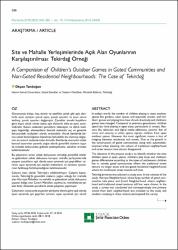| dc.contributor.author | Tandoğan, Okşan | |
| dc.date.accessioned | 2022-05-11T14:32:29Z | |
| dc.date.available | 2022-05-11T14:32:29Z | |
| dc.date.issued | 2018 | |
| dc.identifier.issn | 1300-7319 | |
| dc.identifier.uri | https://doi.org/10.14744/planlama.2018.24008 | |
| dc.identifier.uri | https://hdl.handle.net/20.500.11776/7570 | |
| dc.description.abstract | In today's world, the number of children playing in open outdoor spaces like gardens, open spaces and especially streets, and children's games and playing time have shrunk drastically and children's games have changed. Compared to previous generations, children spend less time playing in open areas, particularly, in streets. Reasons like television and digital media addictions, parents' fear of crime and security in urban spaces repress children from open outdoor spaces. However, the most significant reason is loss of integrity between residences and streets. Due to the growth in the construction of gated communities along with automobile-oriented urban planning, the culture of traditional neighborhood and street texture have almost disappeared. The objective of the present study is to identify whether the time children spent in open spaces, children's play areas and children's games differentiate according to the types of settlements children live in, namely, gated communities where the traditional street texture no longer exists and non-gated residential neighborhoods where the traditional street texture still lives. Tekirdag province was selected as study area. In the context of the study, Hurriyet Neighborhood, where large number of gated communities take place, and Cinarli Neighborhood, where neighborhood and traditional street textures still live, were chosen. In the study, a survey was conducted and correspondingly one primary school from each neighborhood was included to the study and students studying in these schools participated the survey. As a result of the study, it was observed that the time spent in open spaces and children's play areas differentiated according to the types of settlements. Children living in neighborhoods spend more time playing outdoors when compared to children living in gated communities. Children living in neighborhoods mostly prefer playing in the street. On the other hand, street is one of the leading spaces that children cannot access. Children living in gated communities prefer playing in their own gardens or playgrounds and green spaces in gated communities. | en_US |
| dc.language.iso | tur | en_US |
| dc.publisher | Kare Publ | en_US |
| dc.identifier.doi | 10.14744/planlama.2018.24008 | |
| dc.rights | info:eu-repo/semantics/openAccess | en_US |
| dc.subject | Children's play | en_US |
| dc.subject | gated community | en_US |
| dc.subject | neighborhood | en_US |
| dc.subject | street | en_US |
| dc.subject | Physical-Activity | en_US |
| dc.title | Site ve Mahalle Yerleşimlerinde Açık Alan Oyunlarının Karşılaştırılması: Tekirdağ Örneği | en_US |
| dc.title.alternative | A Comparision of Children's Outdoor Games in Gated Communities and Non-Gated Residential Neighbourhoods: the Case of Tekirdag | en_US |
| dc.type | article | en_US |
| dc.relation.ispartof | Planlama-Planning | en_US |
| dc.department | Fakülteler, Güzel Sanatlar Tasarım ve Mimarlık Fakültesi, Mimarlık Bölümü | en_US |
| dc.identifier.volume | 28 | en_US |
| dc.identifier.issue | 3 | en_US |
| dc.identifier.startpage | 348 | en_US |
| dc.identifier.endpage | 365 | en_US |
| dc.institutionauthor | Tandoğan, Okşan | |
| dc.relation.publicationcategory | Makale - Uluslararası Hakemli Dergi - Kurum Öğretim Elemanı | en_US |
| dc.identifier.wos | WOS:000454206800007 | en_US |



















